市场资讯及洞察

Most traders understand EA portfolio balance through the lens of traditional risk management — controlling position sizes, diversifying currency pairs, or limiting exposure per trade.
But in automated trading, balance is about deliberately constructing a portfolio where different strategies complement each other, measuring their collective performance, and actively managing the mix based on those measurements.
The goal is to create a “book” of EAs that can help diversify performance over time, even when individual strategies hit rough patches.
A diversified mix of EAs across timeframes and assets can, in some cases, reduce reliance on any single strategy. This approach reduces dependency on any single EA’s performance, smooths your overall equity curve, and builds resilience across changing market conditions.
It’s about running the right mix, identifying gaps in your coverage, and viewing your automated trading operation as an integrated whole rather than a collection of independent systems.
Basic Evaluation Metrics – Your Start Point
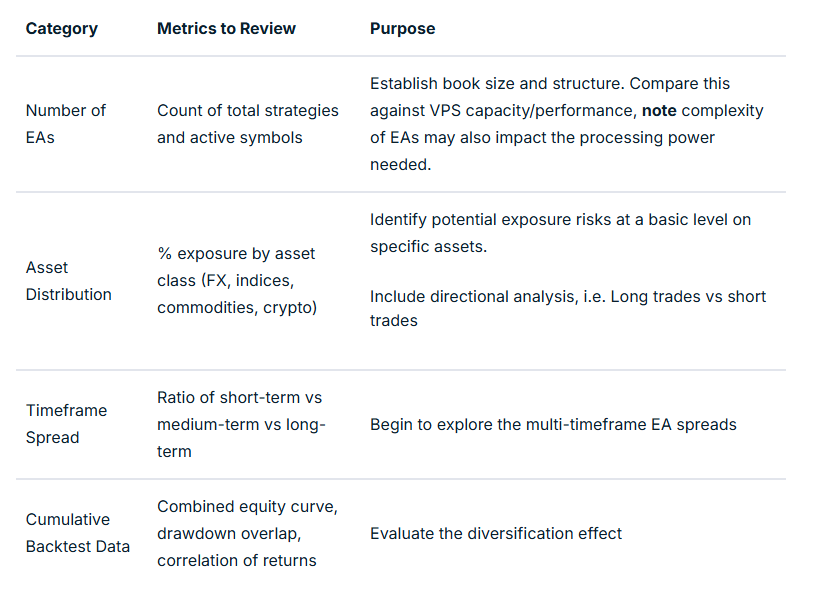
Temporal (timeframe) Balancing
When combined, a timeframe balance (even on the same model and instrument) can help flatten equity swings.
For example, a losing phase in a fast-acting M15 EA can often coincide with a profitable run in an H4 trend model.
Combining this with some market regime and sessional analysis can be beneficial.
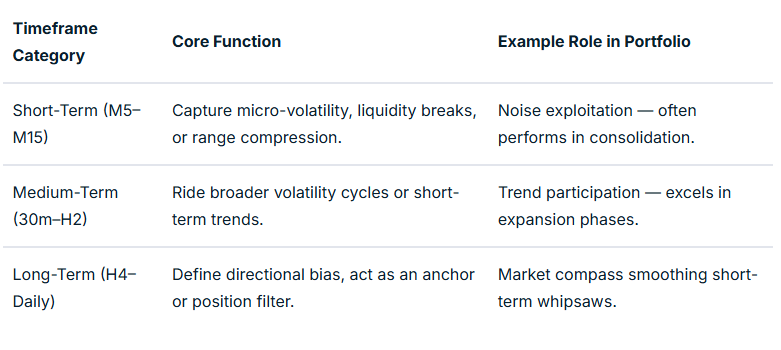
Asset Balance: Managing Systemic Correlation Risk
Running five different EAs on USDJPY might feel diversified if each uses different entry logic, even though they share the same systemic market driver.
But in an EA context, correlation measurement is not necessarily between prices, but between EA returns (equity changes) relating to specific strategies in specific market conditions.
Two EAs on the same symbol might use completely different logic and thus have near-zero correlation.
Conversely, two EAs on a different symbol may feel as though they should offer some balance, but if highly correlated in specific market conditions may not achieve your balancing aim.
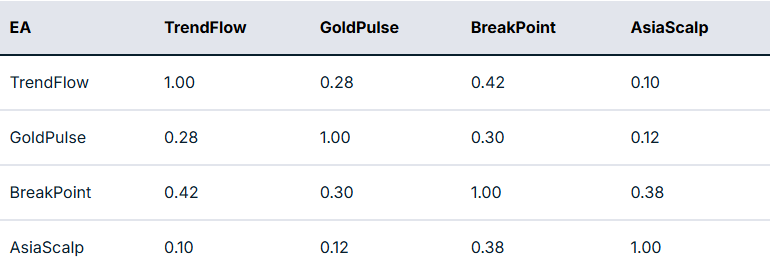
In practical terms, the next step is to take this measurement and map it to potential actionable interventions.
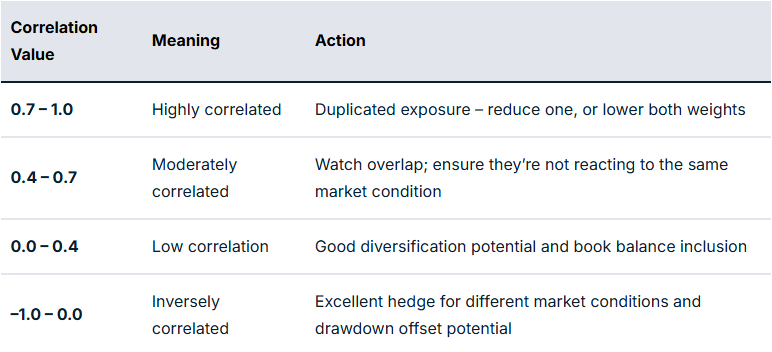
For example, if you have a EURUSD Trend EA and a GBPUSD Breakout EA with a correlation of 0.85, they are behaving like twins in performance related to specific market circumstances. And so you may want to limit exposure to some degree if you are finding that there are many relationships like this.
However, if your gold mean reversion EA correlates 0.25 compared to the rest of your book, this may offer some balance through reducing portfolio drawdown overlap.
Directional and Sentiment Balance
Markets are commonly described as risk-on or risk-off. This bias at any particular time is very likely to impact EA performance, dependent on how well balanced you are to deal with each scenario.
You may have heard the old market cliché of “up the staircase and down the elevator shaft” to describe how prices may move in alternative directions. It does appear that optimisation for each direction, rather than EAs that trade long and short, may offer better outcomes as two separate EAs rather than one catch-all.
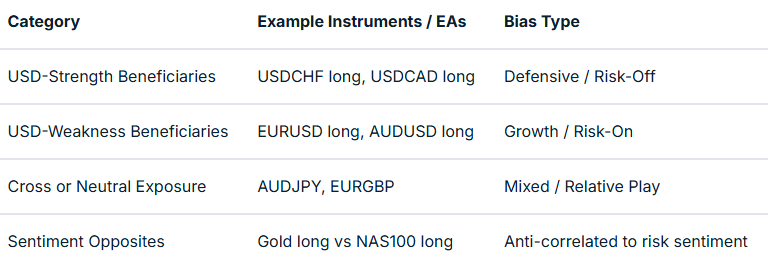
Market Regime and Volatility Balance
Trend and volatility states can have a profound impact on price action, whether as part of a discretionary or EA trading system. Much of this has a direct relationship to time of day, including the nature of individual sessions.
We have a market regime filter that incorporates trend and volatility factors in many EAs to account for this. This can be mapped and tested on a backtest and in a live environment to give evidence of strategy suitability for specific market conditions.
For example, mean reversion strategies may work well in the Asian session but less so in strongly trending markets and the higher volatility of the early part of the US session.
As part of balancing, you are asking questions as to whether you actually have EA strategies suited to different market regimes in place, or are you using these together to optimise book performance?
The table below summarises such an approach of regime vs market mapping:
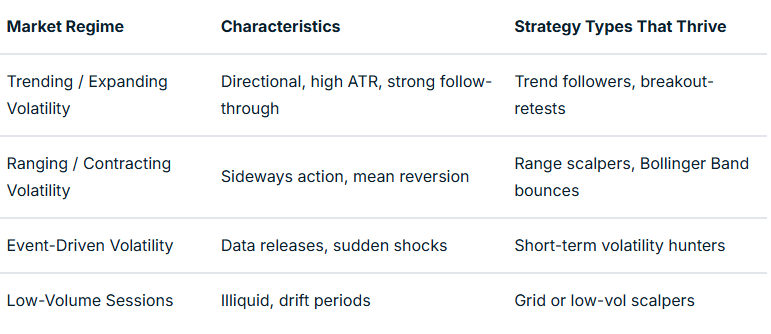
Multi-Level Analysis: From Composition to Interaction
Once your book is structured, the challenge is to turn it into something workable. An additional layer of refinement that turns theory and measurement into something meaningful in action is where any difference will be made.
This “closing the circle” is based on evidence and a true understanding of how your EAs are behaving together. It is the step that takes you to the point where automation can begin to move to the next level.
Mapping relationships with robust and detailed performance evaluation will take time to provide evidence that these are actually making a difference in meeting balancing aims.
To really excel, you should have systems in place that allow ongoing evaluation of the approaches you are using and advise of refinements that may improve things over time.
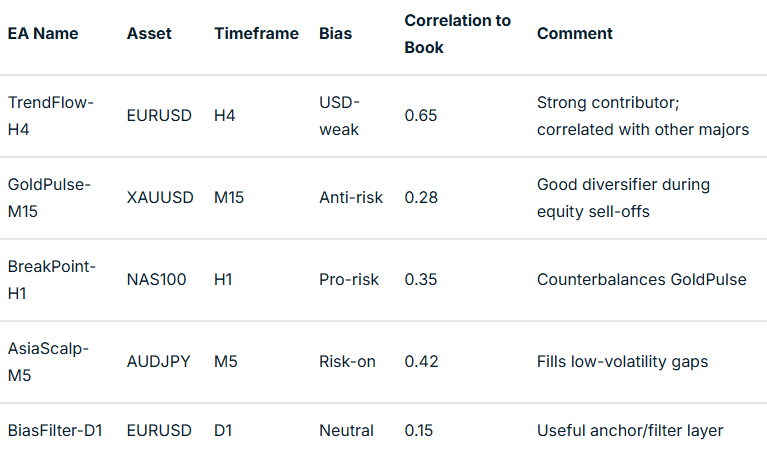
What Next? – Implementing Balance in Practice
Theory must ultimately translate into an executable EA book. A plan of action with landmarks to show progress and maintain motivation is crucial in this approach.
Defining classification tags, setting risk weights, and building monitoring dashboards are all worth consideration.
Advanced EA traders could also consider a supervisory ‘Sentinel’ EA, or ‘mothership’ approach, to enable or disable EAs dynamically based on underlying market metrics and external information integrated into EA coding decision-making.
Final Thoughts
A balanced EA portfolio is not generated by accident; it is well-thought-out, evidence-based and a continuously developing architecture. It is designed to offer improved risk management across your EA portfolio and improved trading outcomes.
Your process begins with mapping your existing strategies by number, asset, and timeframe, then expands into analysing correlations, directional bias, and volatility regimes.
When you reach the stage where one EA’s drawdown is another’s opportunity, you are no longer simply trading models but managing a system of EA systems. To finish, ask yourself the question, “Could this approach contribute to improved outcomes over time?”. If your answer is “yes,” then your mission is clear.
If you are interested in learning more about adding EAs to your trading toolbox, join the new GO EA Programme (coming soon) by contacting [email protected].


本周伊始,美股三大指数表现趋于疲弱,尽管整体尚未出现显著回调,但技术面已显现压力迹象。纳斯达克和标普500昨晚冲高后回落,连续两日收盘形成“倒T”形态,显示短线上涨动能趋弱。包括AI、稳定币、核电等前期热门板块纷纷高位震荡,盘中交易量显著放大,资金获利了结迹象明显。随着七月进入下旬,叠加关税政策观察期临近、三季度季节性弱势特征,市场避险情绪升温。近期启动的美股财报季表现平淡,未能带动市场情绪。本周谷歌和特斯拉财报将登场,市场预期较为保守。短线操作上建议适当收缩仓位,锁定收益,静待八月初更多政策与基本面信号。对于中长线持仓,仍可重点关注具备稳定现金流的价值型个股。消息面上,白宫方面释放稳定信号,表示不会更换美联储主席;欧美之间讨论进一步对俄经济措施,但贸易政策方面暂无突破。地缘紧张背景下,黄金价格大幅拉升,一度突破3400美元,相关金矿股集体走强。与此同时,AI板块仍具波段机会,英伟达、PLTR走势稳定,而CRCL和部分AI医疗个股动能不足。

币圈方面,前期大涨的稳定币概念明显出现获利回吐,Circle走势疲弱,市场对其后续估值预期下调。部分小盘币种波动剧烈,短线风险升高。值得留意的是,特朗普预计于本月23日公布其AI发展政策,相关基础技术与应用型公司或再迎一波关注。外汇方面,美元指数受压调整,澳元兑美元站稳0.65,美日跌破148大关,美元兑人民币稳定于7.17附近,澳元兑人民币回升至4.68。原油价格维持区间震荡,美油主力合约围绕66美元运行,整体波动较温和,市场正在寻找新的推动方向。联系方式:墨尔本 03 8658 0603悉尼 02 9188 0418中国地区(中文) 400 120 8537中国地区(英文) +248 4 671 903作者:Xavier Zhang | GO Markets 高级分析师


今日澳洲股市整体走弱,ASX 200指数下跌1.02%,11大板块悉数下挫,其中金融板块跌幅最大,成为市场主要拖累。由于澳洲央行迟迟未释放降息信号,叠加银行类股前期涨幅较大,回调压力逐步释放,市场情绪趋于谨慎。在普遍下行的环境中,能源与原材料板块逆势上涨成为亮点。核电主题继续受到关注,澳洲铀矿相关个股集体回暖,即便在国际铀价横盘的背景下依旧稳中有升;锂电池制造商NVX受益于美国对华石墨限制,今日上涨超10%。大型矿商方面走势稳健,FMG上涨逾1%,BHP小幅收红,MIN上涨超3%。相对地,金融与地产股承压,CBA下跌超过2.5%,GMG下跌近1%。隔夜美股走势依旧强势,主要股指期货小幅上扬。近期表现抢眼的AI、稳定币及核电等题材仍有资金持续流入。美元指数继续回调,日内跌近98关口,推动金价一度上涨至每盎司3370美元附近,涨幅近0.6%。地缘因素方面,以色列周末空袭叙利亚令中东局势再度升温,避险情绪有所升温。恐慌指数小幅下行,油价震荡不大,美油期货围绕66美元运行。外汇方面,美元整体承压带动非美货币短线反弹,美元兑日元跌破148关口,澳元兑美元上涨0.2%,重新站上0.65,美元兑人民币被压制在7.18之下,澳元兑人民币也进一步回升至4.68附近。免责声明:GO Markets 分析师或外部发言人提供的信息基于其独立分析或个人经验。所表达的观点或交易风格仅代表其个人;并不代表 GO Markets 的观点或立场。 联系方式:墨尔本 03 8658 0603悉尼 02 9188 0418中国地区(中文) 400 120 8537中国地区(英文) +248 4 671 903作者:Xavier Zhang | GO Markets 高级分析师


Most traders follow a familiar routine when planning trades:They scan for a setup — a candlestick pattern, a moving average crossover, or a favourite indicator alignment. When they find one, they take the trade, set a stop somewhere "logical," and target a multiple of their risk.And, there is nothing wrong with this! It is systematic and structured, and if it is based on a specific set of unambiguous criteria within your trading plan, it can work to your advantage. But, perhaps there is another way to achieve improved trading outcomes?The potential flaw in the “every trader does it” approach is subtle but can be critical. It assumes that the setup itself automatically means the market will move as far as you expect, and be clean enough for the trade not to be impacted by market noise.However, without a logical, higher probability exit point, your supposed great entry could quickly turn into the wrong trade.This is where reverse engineering your trade (starting with the exit) comes in.
What Is Reverse Engineering in Trading?
Instead of beginning with the entry, you start with a different question: "Where is price most likely to go — and is there a logical reason for it to get there?"You look for the destination or a ‘zone’ where the price has a high probability of pausing or even reversing. Current price action is often dictated by previous price action to some degree. This could be a support or resistance area, a previous swing high or low, or a volatility cluster that you may expect the market to seek out and price to hit.Once you have identified this likely exit point, you work backwards:
- Is there enough space between the current price and this target for the trade to offer a meaningful reward compared to the risk you are taking?
- Where would a logical stop be to make this trade viable from the perspective of my own risk/reward profile?
- Do current conditions make this trade worth entering now, or would it be prudent to wait?
Instead of forcing entries every time a setup appears, you filter opportunities through a forward-looking lens of probability based on what could happen based on price action.
Why the Exit-First Approach May Give You an Edge
When your focus is primarily on entry patterns, your risk-reward may suffer without you realising it. You may end up chasing trades where price has little room to move, ignoring close potential pause points in order to justify the trade, so squeezing risk-to-reward into the desire to simply get in, or worse, jumping in right before price reverses on you.The exit-first mindset, although perhaps seeming a little pedantic, may encourage you to engage more frequently in trades where:
- The market context supports a move in your favour.
- The price destination, and so reward, offers both logical and likely potential.
- The risk-to-reward is completely justified, without letting some of the “force a trade” demons take hold, resulting in you pressing the entry button without checking this.
This alternative approach in how you view trade decisions does not mitigate the necessity to place meaningful stops or trail positions, but it could have the ability to force you to trade with the bigger picture in mind, not just the immediate momentary signal.
How to Reverse Engineer a Trade
Step 1 — Define a High-Probability Exit Zone
Study the chart and identify where and why the market has a reason to go to a particular price point.This is not about predicting the future per se, but about recognising where price may be naturally drawn based on observable market structure and previous price behaviour.These zones often include areas like:
- A price level that has respected a support or resistance level on multiple occasions.
- A prior (and usually relatively recent) swing high or low that acted as a turning point.
- Major round numbers that commonly attract stop positioning.
These zones often act like magnets; they can be points where market participants have historically placed orders (and may have more pending orders) or reacted strongly in the past.With the focus on these likely destinations first, you force yourself to consider the broader market context before setups. Even if we like to think we will take this into account in any entry decision, to make it your thinking start point, rather than the excitement of a new set-up, is a logical way to keep those emotions channelled correctly.
Step 2 — Assess the Trade Space Between Price and Target
With your potential price destination mapped out with clear reasoning, the next step is to examine the space between the current price and your identified target zone.Make the decision as to whether the market offers a meaningful opportunity, or if it is already too late to enter to justify the risk.This is where you assess your reward potential relative to your probable stop-loss size.For example, if the price is only a few pips or points away from your exit target, it may not be worth entering, even if the setup appears to meet your planned entry criteria. Conversely, if price is a defined distance away from your end point, with enough space to move and few hurdles to negotiate (e.g., previous pause points), that could be the opportunity you are looking for.
Step 3 — Identify a Low-Risk Entry Within That Trade Space
Now you look for your familiar entry triggers — within a clearly defined context where you already know:
- The price you are targeting.
- How much room price could move before it hits your identified zone
- Where a stop could be placed logically whilst still retaining a desirable risk/reward ratio.
You may choose to wait for a pullback to a previous key level and confirmation of a bounce, evidence of increasing momentum, or look for confirmation of a continued directional move in price action patterns.So, you are entering with a plan built around where price is going and not just reacting to where price may be right now.Once you have practiced this a few times, this is an approach you can pre-plan, perhaps even prior to market open. Identifying your top 3 could provide clear guidance for the session ahead.
What This Approach Changes About Your Trading Psychology
Trading with the end in mind can help shift your focus from one of reacting to one of improved planning. The aim is to more naturally:
- Take fewer, higher-quality trades.
- Avoiding emotional decisions based on the ‘heat-of-the-moment’ setups and considering context more fully
- Managing your trades with more clarity as you understand the complete structure you are trading
Summary
We are not suggesting for one moment that you should abandon what you are doing now, particularly if it is yielding great results. This is an alternative that may be worth adding to your trading toolbox to potentially harness the power of trading with the end in mind. Reverse engineering your trades is a different way of looking at things, and probably a very new way of thinking about the market that differs from what is traditionally taught.It will by default force you to look at and respect structure, context, and reward potential before you ever consider pulling the trigger.By starting with the exit in mind, you naturally filter out lower-quality trades, focus on logical market movement, and step away from the emotional pull of “setup chasing.”It is also worth re-emphasising that there is no difference in the need for a carefully crafted and tested trading plan between this and any other strategy.


美国稀土板块近期迎来了 显著上涨周期 ——尤其是MP Materials因两大重磅合作推动下股价暴涨,同时USA Rare Earth作为受益者也跟随大幅上扬。稀土龙头抬起,引领行业爆发7月16日美国国防部斥资4–6亿美元入股MP Materials,持股超15%,并签署长期高价采购协议,正式将其定位为战略级资源企业;与此同时,苹果也于同日宣布追加5亿美元投资,用于稀土磁体生产与回收设施建设,推动稀土进入高科技核心供应链、加速去中国化。受此双重利好推动,MP股价两日内(7月15–16日)暴涨超80%,市值从50亿美元跃升至近130亿美元,投行上调目标价至60~64美元以上。强势龙头效应引爆整个稀土概念板块,市场资金集中涌入,稀土成为当前热点投资主线。为何美国突然重视稀土?在化学元素的江湖里,有一群被叫做“稀土”的家伙,总共17位,包括镧、铈、钕、镨、钐、铕、钆……名字听着冷门,但个个身怀绝技,是现代科技的“幕后英雄”。虽然叫“稀土”,其实它们并不稀少,只是提取困难、分离复杂,就像从一大碗沙子里精准抓出17种颜色的米粒。稀土就像现代科技的“调味料”和“维生素”,少量但关键——没有它,飞机飞不了,手机亮不了,新能源车跑不了,导弹也瞄不准。目前,中国掌握了全球约60%-70%的稀土生产与提炼能力,就像“炼丹炉”级别的顶级厨师,全世界的高科技公司都在排队订货。4月4日,中国商务部将七类中重稀土元素及稀土磁体纳入出口许可管理,限制对美出口,以回应美方关税,5月日内瓦谈判后,中美达成初步谅解,中国承诺缓解对稀土出口的非关税限制,稀土可以说就是中国贸易谈判的王牌,不管美国出什么招,中国只要亮出稀土,美方就要谨慎考虑。中国以“示牌不出牌”的方式,让稀土成为博弈中的象征武器;而美国则以国家安全为由,加速构建非中国稀土产业链,所以才有前面对美国本地稀土的一系列利好政策。稀土板块的暴涨能否持续?政策上是绝对的利好,美国要摆脱中国稀土卡脖子,大力发展自己的稀土产业。需求方面,清洁能源与高科技产业对稀土的需求持续增长。但替代技术和循环利用可能在中长期减缓稀土需求增速。特斯拉宣布下一代电机将不使用稀土永磁体,苹果公司则计划2025年实现其产品中磁体100%使用回收稀土。新材料、提炼技术和稀土回收的发展未来或降低对原生稀土的依赖。我们对此进行一个小总结:短期来看,在政策扶持、供应安全考量及需求增长的推动下,美国稀土板块的涨势短期内具有一定可持续性。中期来看,随着本土产能逐步释放、技术替代开始涌现,稀土板块涨势可能趋于放缓。但考虑到稀土在新能源和国防领域的战略地位,中期仍将获得一定支撑。联系方式:墨尔本 03 8658 0603悉尼 02 9188 0418中国地区(中文) 400 120 8537中国地区(英文) +248 4 671 903作者:Mill Li | GO Markets 墨尔本中文部


Bitcoin hit a new all-time high (ATH) on July 14, rising to $122k for the first time in its history. On this same day in 2010, a single Bitcoin was worth… $0.07.This incredible rise from a near-worthless digital experiment to a $2.5 trillion asset class begs the question: What is it exactly that makes Bitcoin so valuable?[caption id="attachment_712157" align="alignnone" width="1835"]
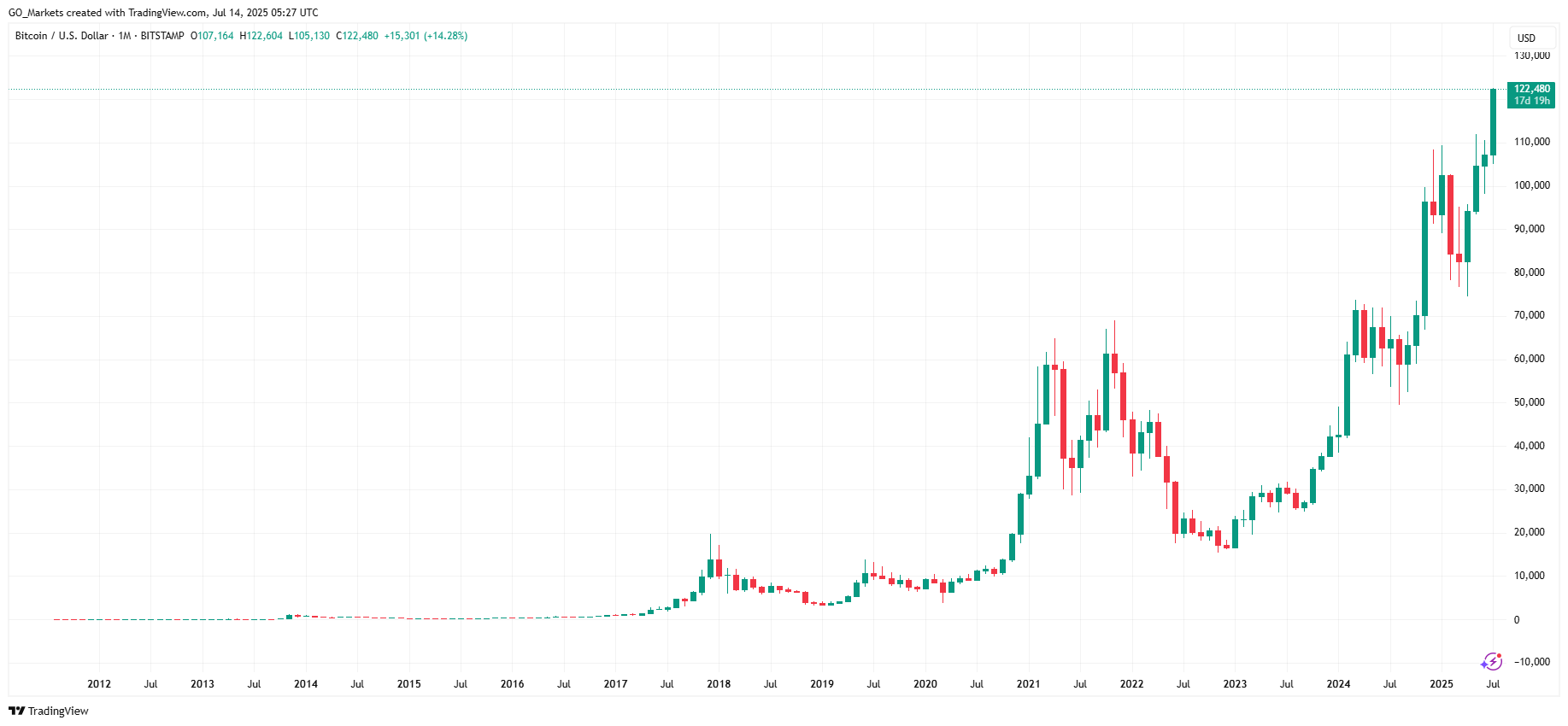
Bitcoin price 2012-2022[/caption]
What Gives Any Currency Its Value?
Since the dawn of organized trade, humans have searched for what economists call "sound money" — a currency that facilitates transactions while still maintaining value over time.
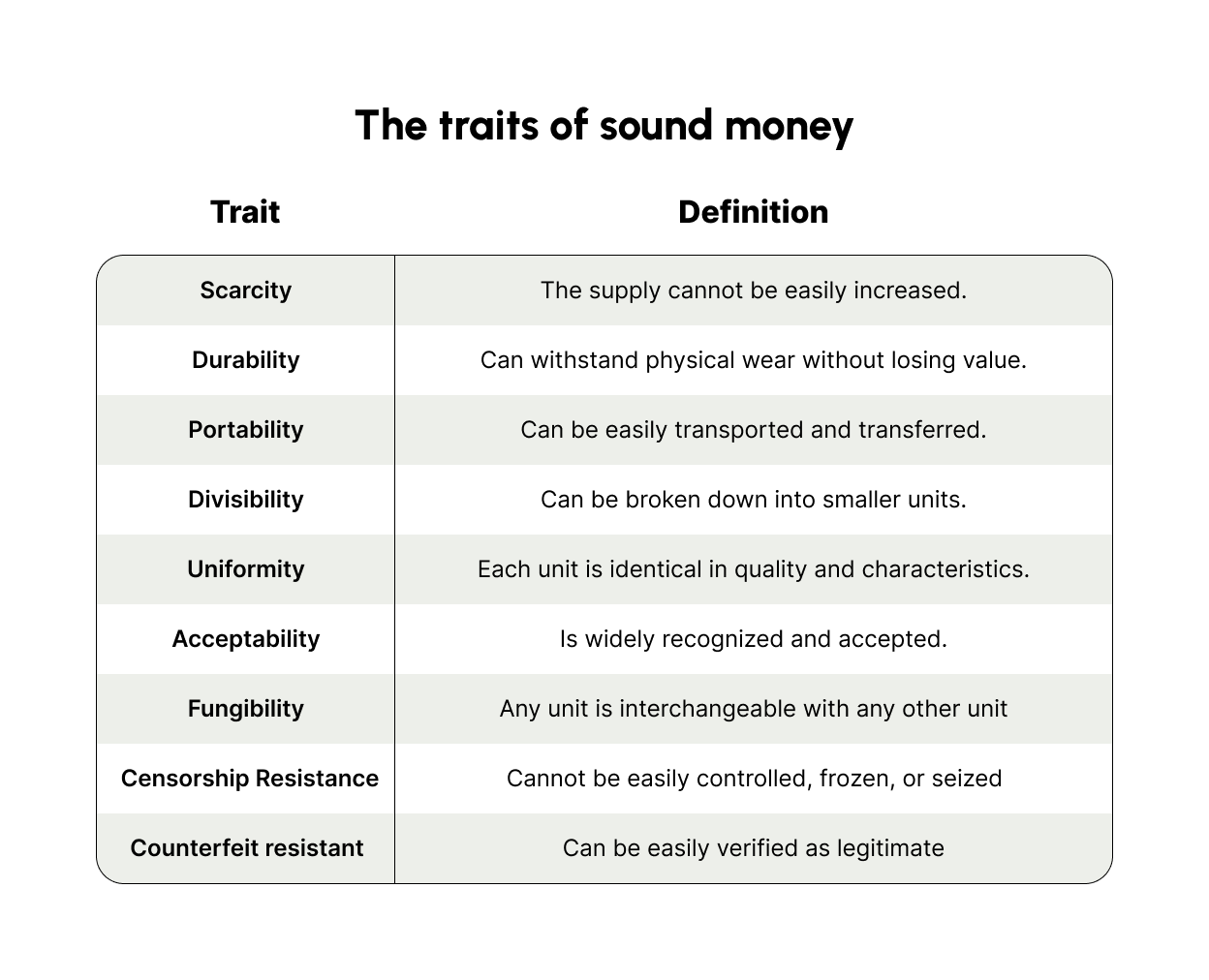
After centuries of trial and error, gold eventually emerged as the universally accepted currency. Its scarcity, durability, and divisibility made it great for storing and transferring value. But physical gold wasn’t able to satisfy all the traits of sound money — it was heavy, difficult to transport, and vulnerable to theft during long-distance trade.To address these limitations, a new solution was found — countries began issuing paper currency guaranteed by the government, backed by gold reserves.This paper currency is (more or less) the currency we know today. And for the past few hundred years, it was the currency that satisfied the most requirements for sound money.However, as we entered the digital age, the idea that a “digital currency” could be created to satisfy all sound money criteria began to gain traction.This is where Bitcoin comes in.
The Bitcoin Breakthrough
Multiple attempts to create a digital version of sound money were made throughout the 1990s and 2000s. But they all ran into the same problem: double spending.The inherent issue with anything digital is that it can be easily copied. There needed to be a way to prevent people from simply copying a digital currency file and “double-spending” it in multiple places.This created a situation where the last two traits of sound money — Censorship Resistance and Counterfeit Resistance — could not be satisfied simultaneously.To satisfy Counterfeit Resistance, double spending had to be prevented. To prevent double spending, a central authority was needed to verify transactions, which opened up the currency to censorship.It wasn’t until 2008, when a paper named “Bitcoin: A Peer-to-Peer Electronic Cash System“ was innocuously sent to a cryptography mailing list, that a solution was discovered.Instead of relying on a central authority, Bitcoin proposed a distributed network where every participant keeps a copy of every transaction that has ever occurred.This shared ledger (now better known as “the blockchain”) is maintained by a network of thousands of computers (nodes) around the world. When someone wants to send Bitcoin, they need to broadcast their transaction to the network. The computers then work together to verify that the sender actually owns the Bitcoin and hasn't already spent it elsewhere.If everyone has a complete record of all transactions, double spending becomes impossible. You can't spend the same Bitcoin twice because the entire network can see your complete transaction history.This breakthrough meant, for the first time, a form of currency existed that could (theoretically) satisfy all the traits of sound money.
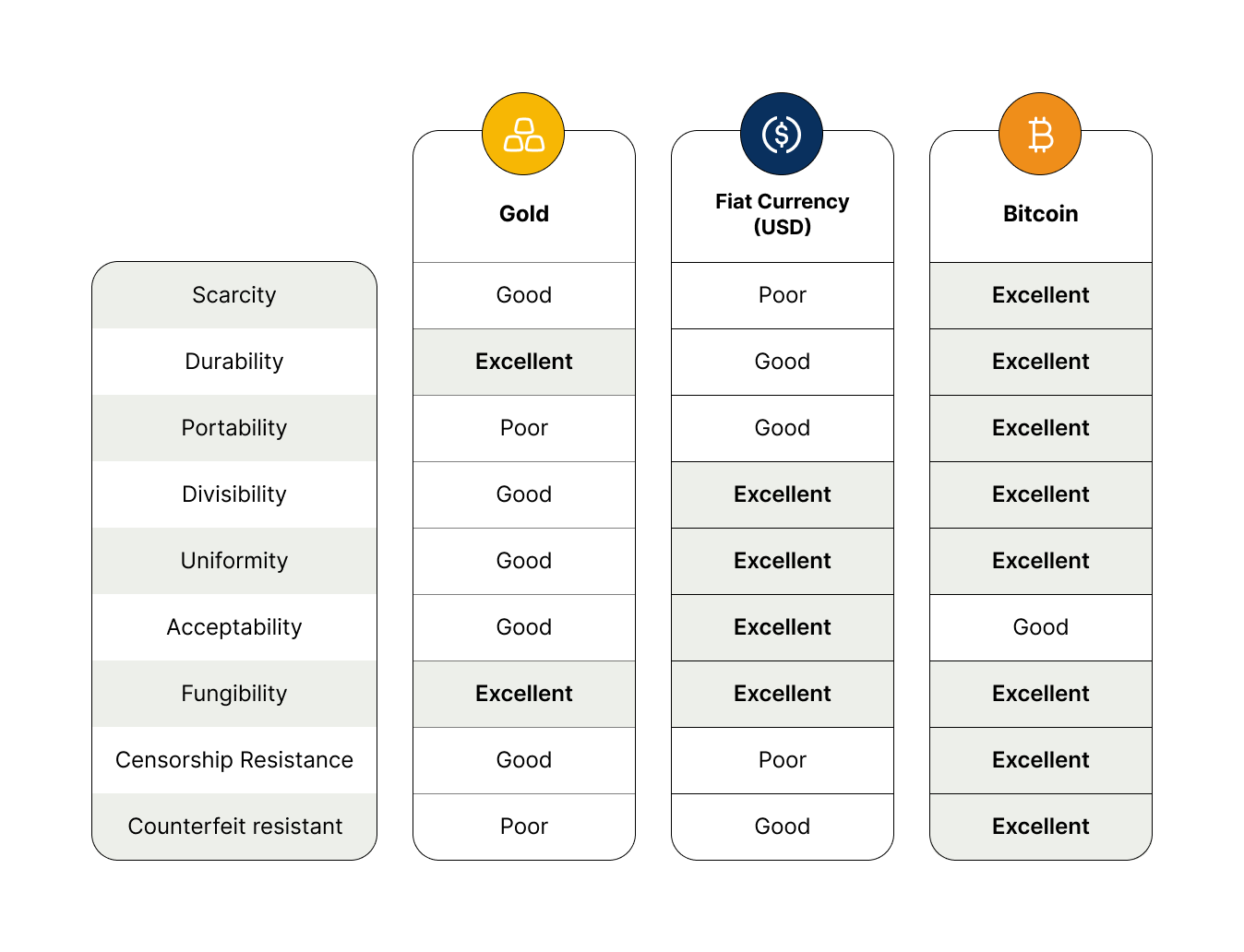
However, the fact that Bitcoin satisfies these traits does not automatically make it valuable.Bitcoin’s “sound money” breakthrough was just a novelty; it still needs practicality with a clear fundamental value add to justify having any worth.
What Gives Bitcoin Its Fundamental Value?
It created a new technology. The blockchain solution was far more reaching than just preventing double-spending. Blockchain introduced a way to create permanent, tamper-proof records without requiring a central authority to maintain them.This unlocked possibilities across virtually every industry. Everything that previously required a trusted middleman to verify, record, or enforce agreements could now be rebuilt on this trustless infrastructure.It has absolute scarcity. Bitcoin's supply is permanently capped at 21 million coins, written into its code and enforced by the network. This creates predictable, verifiable scarcity. Unlike gold, where new deposits can be discovered, Bitcoin's scarcity is mathematically guaranteed.It is censorship-resistant. Bitcoin transactions cannot be blocked, reversed, or frozen by governments or financial institutions. This makes it valuable for those living in countries where traditional money systems might be unreliable or compromised.It is globally accessible. Anyone with internet access can send or receive Bitcoin anywhere in the world, 24/7. This makes it particularly valuable in regions with limited banking infrastructure or restrictive governments.Bitcoin is decentralized and secure. Because the Bitcoin network operates through thousands of nodes worldwide, it means no single entity can control, manipulate, or shut down the network.It is transparent and auditable. Every Bitcoin transaction is recorded on its public ledger that anyone can verify. This ledger has been running with 100% uptime for over 12 years, with its only two minor downtime events occurring early in its formative years.
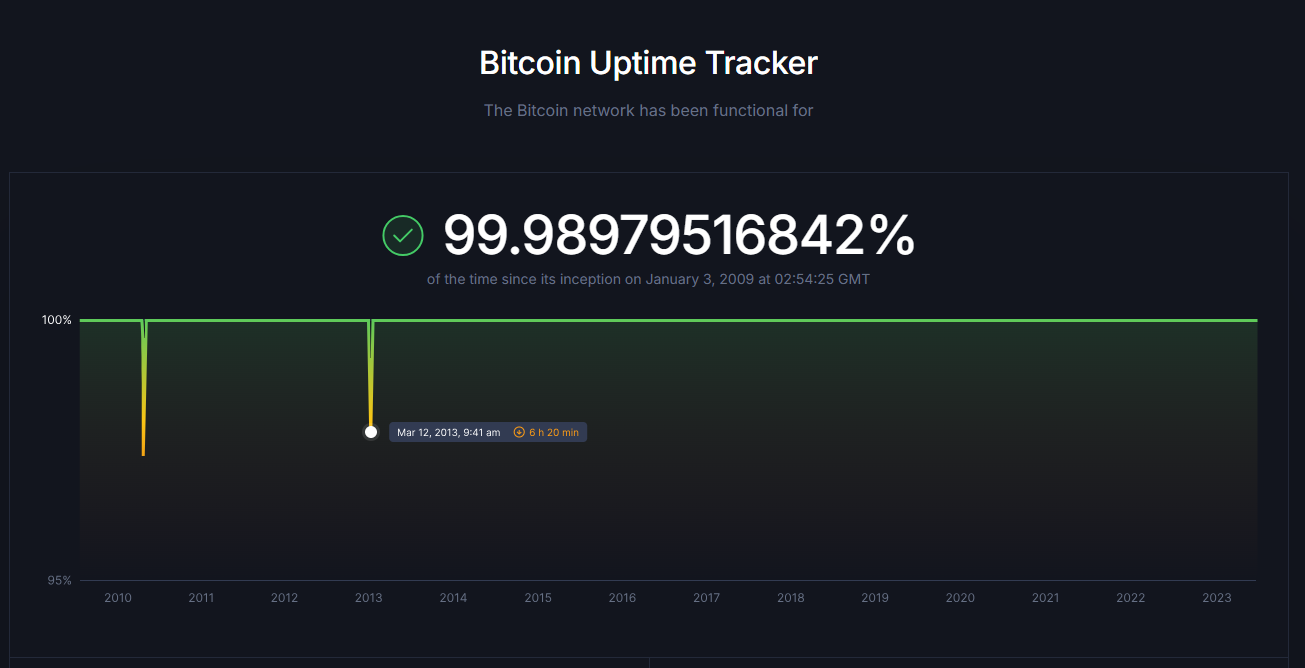
How Much of Bitcoin’s Value is Speculative?
So, Bitcoin has a good fundamental value proposition, but does it justify its nearly $2.5 trillion market valuation?The short answer is no. Just like gold, if you valued it only on its practical usability, its market cap would be significantly lower.Other cryptocurrencies like Ethereum, Solana, and Tron all have a far superior tech stack, yet Bitcoin has a valuation over five times these assets combined.
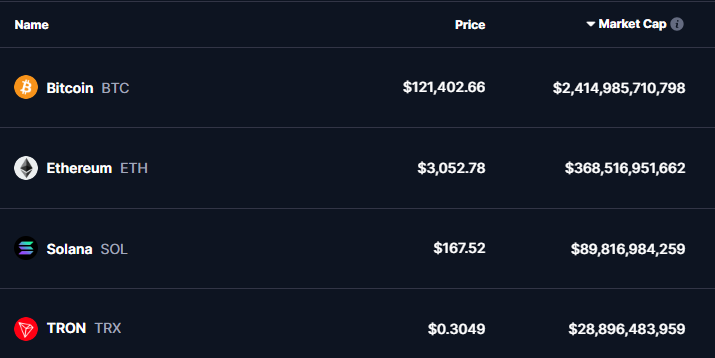
However, like gold, if you start to derive Bitcoin's value from beyond its core functionality, its huge market cap begins to make more sense.Bitcoin has achieved institutional adoption well beyond any of its counterparts. Major corporations, hedge funds, and even nation-states have added Bitcoin to their balance sheets. The most notable of which is MicroStrategy, with current holdings of 597,325 BTC.US Spot Bitcoin ETFs went live in January 2024, the first-ever crypto spot ETF in the US. They have seen over USD$50 billion in combined inflows since launch and generated the biggest first-year inflows on record (beating out Gold ETFs' long-standing record).And Donald Trump has signed an executive order to create a US Strategic Bitcoin Reserve — turning Bitcoin into a national stockpile asset alongside Gold and Oil to help prop up the US Dollar.More nuanced value can also be derived from things like Bitcoin’s 15-yeartrack record of resilience, its community network effects, and the anonymity of its creator — Satoshi Nakamoto.[caption id="attachment_712156" align="alignnone" width="968"]

Sculpture of Satoshi in Switzerland that vanishes from certain angles[/caption]All these factors, combined with its fundamentals, make a strong case for a high Bitcoin valuation. Whether that valuation is as enormous as $2.5 trillion is up for debate. Still, we can be confident that Bitcoin is not a purely speculative asset, like many critics have touted in the past.
Summary
Bitcoin has legitimate technical and economic properties that create genuine value. It is the first form of truly sound money, and it has introduced fundamental innovation that is revolutionary in many ways.However, like many new technologies, the market is still feeling out what it's actually worth. The $2.5 trillion valuation could be justified, or it could be a bubble, or both at different times.What is clear is that Bitcoin isn't going away. Whether it becomes a major part of the global financial system or remains a niche asset, it has established itself as a permanent fixture in financial markets that can't be ignored.Start trading Bitcoin and 38 other Cryptocurrency CFDs on GO Markets today.


There are few trades as appealing, or as risky, as trying to catch a market reversal. The idea of entering at the turning point and riding the new trend is exciting. However, most traders fail to consistently produce good trading outcomes on this potential, often entering too early without confirmation, and thus get caught at a pause point of a continuing powerful move.Trend reversals can indeed offer excellent reward-to-risk potential, but as with any trading approach, only when approached systematically, the confluence of key factors, and timing.
What Is a High-Probability Entry?
Before diving into reversals specifically, let’s define what we mean by a high-probability entry.A high-probability entry is a trade taken in conditions where:
- There is clear evidence from price action and structure
- There is an alignment with the overall market context, such as timing, favourable price levels, and volatility
- Risk can be logically defined and limited to within your tolerable limits
- It may offer a favourable risk-to-reward profile (providing you execute following a pre-defined plan)
This approach should underpin all trading strategy development. And be consistently executed according to your defined rules, which must be constantly reviewed and refined based on trading evidence.
Reversal vs. Retracement: Know the Difference
Many traders confuse a retracement with a reversal, often with potentially costly consequences. It is ok to exit on a retracement and be ready to go again if there is a breach of the previous swing high. But this must be part of your plan, with a strategy for trend continuation in place. However, if your plan suggests that you DON’T want to exit on retracements, then the following table gives some guidance on what potential differences may be. RetracementReversalA temporary move against the trendA complete shift in directional controlPrice often continues in original directionPrice begins trending in the opposite directionHealthy part of a trend’s rhythmMarks the end of a trendTypically shallow, to a Fib/MA/structureOften deep, may break previous swing structureVolume often reduced after swing high if long or swing low if short.Volume often increased after swing high if long or visa versa.
Understanding Trend Exhaustion
Before any reversal occurs, the existing trend must show signs of exhaustion. This is the first phase of a potential turning point — and one of the most overlooked.
How Trend Exhaustion Looks on a Chart:
- Climactic candles – multiple wide-range bars with expanding bodies.
- Failed breakouts – price pushes through a level but fails to hold.
- Reduced momentum – smaller candles, overlapping wicks, indecision bars.
- Volume spikes with no follow-through – smart money distributing or exiting.
- Multiple tests of the same level – a sign that the trend is running out of energy.
The Anatomy of a High-Probability Reversal
A strong reversal setup typically has three key factors that can be supportive of a of follow-through.
1. Location – Price at a Key Zone
- Major support/resistance level honoured
- Prior swing highs or lows at a similar price point
- Higher timeframe structure – I,e, agreement on a 4 hourly chart as well as an hourly.
In simple terms, if the price isn’t at a meaningful location, a meaningful reversal is less likely to occur.
2. Previous Signs of Trend Exhaustion
We have covered this above, with evidence that the current trend has now weakened, and there is some justification to prepare to enter a counter-trend.
3. Structural Confirmation
This is the trading trigger you are looking for as a potential signal for entry. Structural confirmation transforms an idea (“the price might reverse”) into an actual setup (“the reversal is underway”).Look for the following four signs:
- Trendline or key short-term moving average breached
- Lower highs and lower lows in an uptrend or higher lows in a downtrend
- Confirmation that a key swing point has been honoured
- Evidence that a retest and rejection of the broken structure has occurred.
This shows that momentum has not just stalled, it has now shifted.
Context Filters
Reversals are more likely to succeed when conditions are supported by other factors. This is to do with the identification of a strong market context where reversals are more likely to happen. These may include:
- Time of day: The open of London or US sessions, or into session close when there may be some profit taking on a previously strong move
- Volatility extremes: Price has expanded beyond its normal daily range (ATR-based or visually evidenced on a chart)
- Market sentiment: Everyone is already long at the top or short at the bottom — setting up for a squeeze
- Catalysts: Reactions to news, or data, that may cause a significant one-sided move
Adding context could make the difference between a technically correct trade and one that may offer a higher probability of going in your desired direction.
Recognising Common Reversal Patterns
There are classic chart patterns that may help visually reinforce the principles. They reflect exhaustion, rejection, and structural change, and may encourage many traders to follow the move, adding extra momentum to any initial move. PatternSignal TypeKey ClueConfirmation NeededDouble Top/BottomReversal StructureRepeated rejection of key levelBreak of swing low/high between peaksHead & ShouldersMomentum FailureFailed retest after strong pushNeckline breakPin BarExhaustion CandleSharp rejection with long wickOpposite-direction close after the pinEngulfingSudden Power ShiftOne candle overtakes previous rangeFollow-through candleRounding Top/BottomSlow Institutional TurnGradual stalling and reversalNeckline break of curveBreak of Structure (BoS)Structural ConfirmationNew higher low/lower high, support breakRetest and failure to reclaim broken level⚠️ These patterns should not be traded in isolation. Use them with context and only after signs of exhaustion and structure shifts.
FOUR Trader Reversal Traps to Avoid
Even with a solid framework, it’s easy to fall into common traps:
- Trying to pick the exact top or bottom - Wait for price to prove the turn, don’t anticipate and enter early
- Entering against the higher timeframe trend – Zooming out and checking alignment with higher timeframes may be prudent to reduce the likelihood of having to fight momentum on larger timeframes.
- Trading every reversal signal - Not all signals are valid or particularly strong. Look for the confluence of multiple factors covered earlier, not just the presence of a pattern.
- Letting bias override evidence - Just because you want a reversal to happen, it NEVER means it is there unless backed up by evidence.
Don’t Forget the Full Trading Story
A great setup means nothing without excellent execution. These ESSENTIAL facts are critical as with any trade, but there will never be an apology for reinforcing these.
Patience and execution discipline
Wait for your full criteria to be met. Avoid “almost” setups that feel tempting but don’t fully align with your full plan criteria. Likewise, when all your boxes are ticked, then take action.
Exit strategy
Use a mix of targets, structure-based trails, or scaling out, and know in advance how you’ll manage the trade once it starts moving.High-probability entries are only one part of a winning trade. Exit efficiently or you’ll waste great entry setups because of poor execution. There are many traders in this position; make sure you are not one of them.
Summary
High-probability reversals are not about being right at the top or bottom when you enter; this is rarely possible and adds additional risk without confirmation. They are about recognising and being ready when the trend is potentially changing, and taking action when:
- Price is at a key level
- The current trend shows clear signs of exhaustion
- Structure confirms the shift
- And context supports the move
Trade the evidence and your plan, not just what you think is likely to happen. Be patient, be ready, and when the setup is there, execute your trade with confidence.

